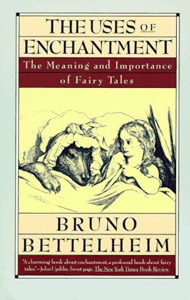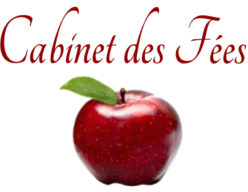The Uses of Enchantment
by Bruno Bettelheim, 1976
Reviewed by B. Haro
 Bruno Bettelheim’s The Uses of Enchantment: The Meaning and Importance of Fairy Tales was published over thirty years ago. In keeping with the author’s then-reputation, it was received well; the book garnered many accolades, including the National Book Award. Since Bettelheim’s death in 1994, his stature as a psychoanalyst and critic have diminished. Notably, this very book can only be acquired second-hand, through used sellers. Whether numerous charges against the book, the plagiarized passages, the overly-Freudian analysis or overlooking of historical development of fairy tales, are fair or accurate, is not for me to determine. I can only ask, “Does the book remain useful for newer audiences and if so, how?”
Bruno Bettelheim’s The Uses of Enchantment: The Meaning and Importance of Fairy Tales was published over thirty years ago. In keeping with the author’s then-reputation, it was received well; the book garnered many accolades, including the National Book Award. Since Bettelheim’s death in 1994, his stature as a psychoanalyst and critic have diminished. Notably, this very book can only be acquired second-hand, through used sellers. Whether numerous charges against the book, the plagiarized passages, the overly-Freudian analysis or overlooking of historical development of fairy tales, are fair or accurate, is not for me to determine. I can only ask, “Does the book remain useful for newer audiences and if so, how?”
The great concern of Bettelheim here is the psychological development and maturity of children, and how fairy tales, if properly conceived and transmitted by adults, aid in this development. Freudian psychoanalysis (with occasional reference to Jung) provides the critical framework by which he interprets the tales, as a species of story distinct from others aimed at children – myths or fables. The book splits into two parts; the first subdivides into general discussion of the pedagogical importance of fairy tales, while elucidating older examples which support the main thesis. The second part hones in on several well-recognized tales, providing more elaborate analysis of the individual stories.
If Bettelheim’s view of childhood development is to be taken at face value, then fairy tales serve as  consciousness-orienting guideposts. They are not active instillers of the morals of a civilization; they are not intended to inculcate the meaning of an individual life. Rather, the stories instigate imaginative interaction within children. The fluidity of a fairy tale intermingles with the fluidity of a child’s personality. The inner world of the latter inhabits the suggestive world of the former. In assuming that the strictures of childhood identity aren’t as tight as those of an adult’s, the act of reading or being read to becomes a kind of play. This state of play allows children, each according to their stage of development, to internalize the fairy tale. The tales in effect become a safe haven where internal desires and conflicts (again, as viewed through a Freudian lens) can be approached, confronted and eventually integrated within the maturing personality. No two children will identify with individual components of each tale in the same way, according to Bettelheim, and this is the beauty of fairy tales: the best of them are designed as open-ended systems that allow for a wide variety of personal interpretation.
Along the path of describing the utility of fairy tales for pedagogical and therapeutic purposes, Bettelheim does address what he considers fundamental properties. I briefly mention a few of them here. One of the more important rules he stresses is that adults must never supply the meanings of fairy tales to children. The growth and maturation that the tales enable must stem from the child’s propensity for working out these meanings on an individual basis. As a supplement to this rule, Bettelheim rather stringently states that the transmission of fairy tales occur in such a way that children can internalize as much as possible, to the degree that his preference is for oral transmission. And should transmission be textual, he recommends illustration-free volumes. Another rule he proposes is that fairy tales must happily end, no matter how arduous the journey to the ending might have been. Although recognizing that even within the most cherished collections, not all tales end in this cheery vein, nevertheless Bettelheim remains a proponent of optimism. Children must be guided to believe that no matter the level of difficulty, all travails will be surmounted in time. The end goal remains the same throughout the book – proper psychological and emotional maturation requires proper models. A fictional character with whom children can identify, but who reaches an untimely end (as in “The Little Matchstick Girl”), according to Bettelheim, could damage childhood development.
Back to the initial question – given Bettelheim’s controversial position in the realm of fairy tale critics, is his book worth a gander? Yes and no. As one way (the psychoanalytic way) of looking at traditional fairy tales, Bettelheim uncovers a number of aspects unique to the genre. His method of sensing patterns within many of the stories remains intriguing. One example is the repetition of threes he notices, and the corresponding inquiry into that psychoanalytical triumvirate (the id, the ego and the superego), as they play out across story after story. So his method is novel and yields indelible insights. The question remains whether such patterns within these older stories were intentional choices or subconscious, and how the answer would impact Bettelheim’s views. Of additional value are Bettelheim’s clinical anecdotes of patients. Sprinkled throughout the book, they serve as a reminder that he was no idle conjecturer, but a man whose time was deeply invested in understanding and explicating models of a healthy childhood.
What the book is not useful for: while it does not require a thorough grounding in depth psychology, I had the feeling that the utility of psychoanalysis as a framework was ultimately short shrifted. Bettelheim tends to fixate on a few key ideas, such as the so-called “Oedipal Complex”. The textual effect is one of redundancy (and frankly, makes for a boring read from time-to-time), rather than the excitement that comes from recognizing patterns. And while, to his credit, he occasionally mentions the fairy tales that do not fit within his schema of interpretation, he generally glosses over them in favor of the ones that favor the pedagogical intent of the book. This is a weakness which seems to suggest that the only worthwhile fairy tales are the ones which fit the definition narrowed for therapeutic selection.
The book remains recommended, as there are plenty of stimulating ideas for the genre. My caveat is that it shouldn’t be taken as the final say on the intersection of fairy tales and psychoanalysis. The substantial additions to both fields since the book’s initial publication should be followed upon.

